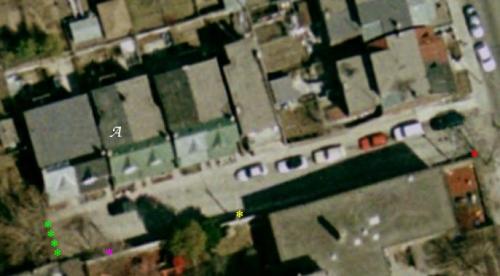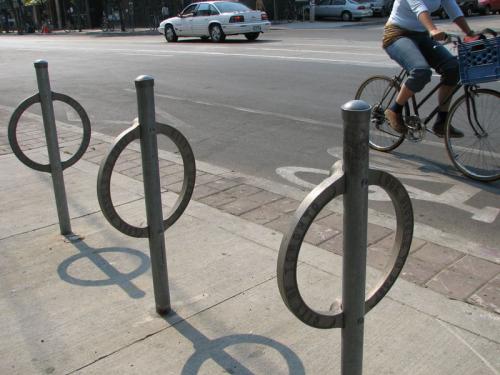Seeing some of the commentary on my first post, I decided that it would be helpful to show you just how the street in question is laid out.

I've taken the liberty to mark the image up with a few points of interest.
The purple asterisk on the south side of the street (near the west end), is the location of the only decent bicycle parking around. It's a guy-wire holding up a utility pole. There's often a bit of low-level competition on the street for access to this space. This space is also frequently obstructed by cars illegally parked on the south side of the street (there is a no parking sign on the utility pole)
Other than the no parking sign, the only signage on the street is the stop sign at the red asterisk (over by the other end of the street). Even if this sign were on a thin enough post for a U-lock to get around (I can't remember if it's attached to another utility pole, or to a chain-link fence), the front wheel would protrude onto the sidewalk for the nearby major street, and the bicycle would be at risk of being damaged by cars turning right as they exit the street.
The yellow asterisk marks another half-passable parking spot; it's a corner in the chain-link fence, where a carefully angled bicycle can actually get its frame close enough to the fencepost that a U-lock can attach the two (though even the best fit is tight).
The green asterisks mark the locations where I think that a row of ring and post stands would fit really nicely.
There are also some points of interest that aren't marked up.
The first is the width of the walkways to the backyards. Noting that a flat roof generally doesn't have an overhang, you can see just how narrow a walkway is available to get a bike into any of the backyards on this street. On top of that, the walkways are cluttered with gas meters, furnace inlets, downspouts, rain barrels, chimneys, and all manner of other obstacles. Maneuvering a bicycle into any of the backyards is very difficult, even with a small/narrow bicycle (and basically impossible with anything bulky).
Continuing into the backyard, you can see that there is no laneway running behind the yards, and that the only outbuilding is a neighbour's toolshed which is too small to accommodate a bicycle.
Also in the backyards, you can see light stripes about a quarter of the way from the back of the houses flat roofs to the back end of the yards; these light stripes are where the back walls of the rear entrances for the houses are. Measuring back from there, you can see that the yards are actually shorter than they are wide, and they're only 14' wide! Installing bike parking in the backyards, even if they were reasonably accessible, would leave no room for clotheslines, garbage cans, or other such frivolities.
Going back to the fronts of the houses, you can see the vegetable gardens that, if they were paved over (never mind that they and the front steps of all the houses are the subject of encroachment agreements, the edge of the road allowance being lined up with the front edges of the porches) would maybe accommodate 2 bicycles without racks or baskets, leaned against each other (so if you're the bottom/inside bike...). The porches have just about the same amount of space, once you leave room for actually getting to the front door.
Also worth noting in front of the houses are the cars. While only 7 cars were parked on the street when this picture is taken, there's easily room for 3 more, and realistically, a 4th extra car can find its way in. It probably warrants a little emphasis that this street, on which I want to see the installation of 8 bicycle parking spaces, already has parking for 11 cars. None of the motorists currently have to contemplate paving over their vegetable garden in order to have a place to safely park their vehicles; that privilege is reserved for the cyclists.
Finally, the last marking on the picture is a script "A" on the roof of my wife's house. In terms of the users of that house, my wife is a cyclist, my step-daughter is a cyclist, my 2-year-old daughter is a cyclist (though she still uses training wheels, and only rides short distances when she's on her own bike instead of in her trailer or child-seat), I am a cyclist, and for the past few years, all of the basement tenants and roommates have been cyclists.
On top of all that, my wife runs a natural health practice out of the house. She actively encourages clients to bicycle to their appointments through promotions (note the winter cycling bonus in part 2), by having minor tools readily available for cycling clients who may need them, and by just plain telling he clients that riding a bike is healthy and they should do it.
In the front hall, she also has a certificate from the city identifying her as a Bicycle-Friendly Business. This is important. You see, right there on the certificate, is my original inspiration for this undertaking. The certificate's list of bicycle-friendly things that businesses can do says, quite plainly, that bicycle-friendly businesses provide bicycle parking.


